Hollywood effects company Flash Film Works used RAYZ on Linux for three recent Warner Bros. productions: the Arnold Schwarzenegger action film Collateral Damage, the Robin Williams dark comedy Death to Smoochy and the Eddie Murphy gangster sci-fi film Pluto Nash (to be released August 16, 2002). “RAYZ has the basic features a compositor should have, plus warp, morph and CineSpeed”, says Flash Film Works Technical Supervisor Dan Novy. RAYZ is a new codebase. Silicon Grail's previous compositor, Chalice, didn't support Linux. “Silicon Grail held discussion groups and polled Chalice users over a year for power-user input”, Novy says. “The RAYZ flipbook is just amazing. It can display 2k resolution in real time. Nodes will cache ahead as it is playing. I can work on the shot as it runs, do color-match changes in real time.” 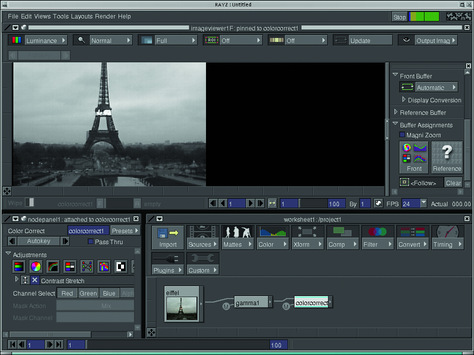 A simple color correction in RAYZ. Top-left is the flipbook preview player. Bottom-right panel is a tree-graph view of attached filters. Bottom-left panel contains settings for selected filter. “In Death to Smoochy RAYZ did a lot of compositing of characters in cars and boats”, notes Novy. “We used RAYZ to add muzzle flashes to guns and for street reflections. We did a lot of 3-D effects on top of 2-D plates.” In one scene, the RAYZ warp and morph feature was used to repair a piece of a physical set that broke during a take. Although other takes had the set intact, the director felt that the take with the set problem had the best performance. “For Collateral Damage we did a lot of retiming”, says Novy. “Retiming 24fps into 36fps creates slow motion where none was shot.” The RAYZ software creates tweens, extrapolating the missing frames. “Retiming may not be flawless, but it's better than double framing. REALVIZ ReTimer is an alternative, but that isn't built-in and would have to be rendered out.” In Collateral Damage, a lot of compositing was done to place Schwarzenegger in front of explosions. 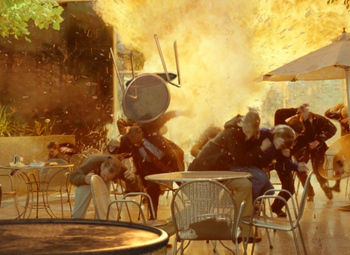 For Collateral Damage, Flash Film Works used RAYZ to composite actors working in front of a blue screen over background footage featuring an explosion, plus additional elements of explosions, debris and a falling pole were added. 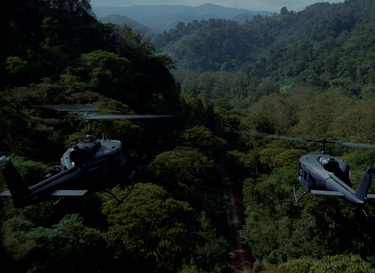 For Collateral Damage--the helicopter on the left is real. The one on the right is a 3-D creation built in Maya and composited into the shot using RAYZ. For Pluto Nash, RAYZ composited in moonscapes created in LightWave on Windows NT and blue-screened with Ultimatte. “The RAYZ net license Ultimatte feature is important to us. Digital Fusion, Combustion and After Effects require a dongle to use Ultimatte. You can't float to any machine like RAYZ.” For a 3-D theme-park ride film, Flash Film Works is developing a plugin to distort the pixels to create parallax. A smoke plume can be adjusted to match the inter-ocular distance and create a composite for each eye. Their plugins are in Perl and C++. Novy is considering a switch from LightWave to Houdini, a popular 3-D package for Linux. After Kodak stopped making the Cineon compositor, Silicon Grail acquired the technology and incorporated it into RAYZ as Grain/Degrain, Sharpen and CineSpeed. “A unique thing about RAYZ is it can keep data in Cineon 10-bit log color format”, points out Novy. “Every other compositor makes you convert to 16-bit linear or to float. With RAYZ you can convert or keep it 10-bit all the way. It will do the internal math with logs.” Video monitors are 8-bit linear and need LUTs (colorspace lookup tables) to approximate film. “Because it was part of the Cineon technology incorporated into RAYZ, it can do full-monitor calibration to bring all our monitors into peak performance.” “RAYZ runs on all of our operating systems and all our hardware”, notes Novy.
Santa Monica-based Island Fever Productions is using RAYZ for visual effects in the 3-D, large-format film Haunted Lighthouse starring Lea Thompson. Due for summer 2002 release at Busch theme parks, the theaters showing the film will incorporate physical effects such as vibrating seats, water and odors. “We're using RAYZ for all the compositing on this movie”, says Island Fever President and Visual Effects Supervisor Nick Ilyin. Compositing a large-format film shot in 65mm is especially demanding. The film is scanned at 4k resolution instead of the usual 2k typical with a 35mm film. “At 2k resolution performance is pretty reasonable, but at 4k RAYZ is handling four times the normal resolution of 35mm. Then, double that for 3-D. Our machines need a lot more memory to handle that. We use 2GB dual-processor workstations.” The 65mm scans are done at IMAGICA and delivered in Cineon DLT format at 4,096 × 1,536 resolution, stereoscopic. The finished 70mm 5-perf prints will be shown using two projectors and with Polaroid glasses for 3-D. Island Fever Productions also uses Linux to create commercials, including three for Orkin showing cockroaches crawling on TV screens. Four commercials for Meijer Toy City feature funny animated penguins. “We created a penguin sculpture that was digitized and brought into Maya for 3-D character animation, then to Houdini for deformation and lighting and compositing, and then output to Pixar RenderMan”, says Ilyin. “We have written a lot of custom code to integrate that pipeline as well as a custom lighting package for Houdini.” Houdini's limited built-in compositor isn't powerful enough for projects like Haunted Lighthouse, which is why Island Fever recently moved to RAYZ for compositing. 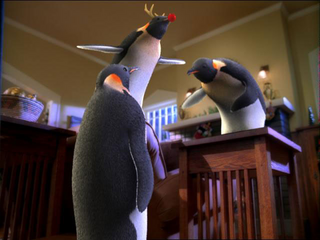 For a Meijer Toy City commercial, 3-D penguins created by Island Fever Productions using Houdini on Linux. MPEG copies of these amusing commercials are on-line at www.island-fever.com/meijer.html. Ilyin says Linux is definitely getting there, but wishes it were more dependable. He sometimes finds his renderfarm locked up, a problem that the industry generally attributes to issues being worked on in the Linux implementation of NFS. “We're hoping to have everything eventually in Linux, but support can be a problem. Red Hat support isn't enough.” Island Fever uses Linux Red Hat 7.1 and 7.2, SGI IRIX and Windows 2000. Drew Perttula is establishing a RAYZ community web site at rayz.bigasterisk.com to offer tips, examples, discussions and code (plugin code and external utilities). As a freelance effects compositor, Perttula has worked on several independent films. “I stumbled upon the beta version of RAYZ back in April 2001”, says Perttula.
For indie film Less Miserables, Perttula is working on a background replacement for a scene shot on Mission Street in San Francisco. Where the street background has the wrong look, it is being adjusted to look more like Mission Street. “It's difficult because the actress' wardrobe presents very soft edges with feathers. Fortunately, I'm able to adapt a University of Washington friend's research to find edges, then import the result into RAYZ.” 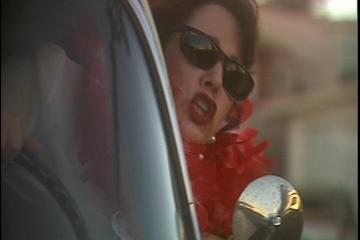 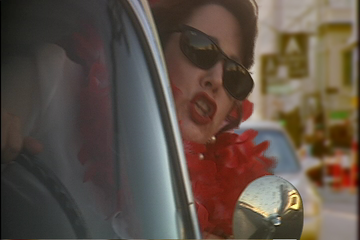 For Less Miserables, a background replacement made difficult by soft edges with feathers (before and after). Less Miserables is a comedy about what can go wrong on a motion picture set. Director Justin Lomba was turned down by HBO's Project Greenlight but produced the film anyway on a $20,000 budget. In one scene, the gag is that a grip shines a reflector directly into the lens of the camera, blinding the cameraman. “The reflector as shot is actually in a shadow, so we have to add the flare in post using RAYZ”, explains Perttula. “In another shot we're hoping to get a friend at PDI to model a 3-D camera crane that I'll composite in to make it look like a bigger movie set.” For Less Miserables, lens flare effect added to reflector by RAYZ in a scene where a clumsy grip holding a reflector is supposed to be inadvertently blinding the camera operator. Another shot for Less Miserables needs people added:
“Projects I worked on at PDI include indie Memories of You”, says Perttula.
For his own project, Golden Memories, Perttula demonstrates a shot from a scene where a woman on vacation is feeding her fish by sending envelopes of fish food by mail. As it falls in the fish tank the envelope disintegrates. Golden Memories screened recently at ROBOTMEDIA, a monthly festival in Berkeley. “I'm taxing RAYZ by making each fragment of the envelope a block. I used Python and Pygame to create the blocks, so I don't need to manually create all the nodes in the RAYZ GUI.” “RAYZ appeals to artists because it has a simpler interface than Shake”, says Perttula.
Perttula says that the ease of having Perl create an overview of how a whole project works is a testament to how easy it is to read RAYZ files and do interesting things with them. To get RAYZ, download the license manager (license_manager.linux.intel.tar.gz) and the application (rayz-2.0.i386.rpm) separately from the Silicon Grail web site. Using alien we converted the RPM to install on our Debian system. The alien tool handles conversions between Red Hat RPM, Debian deb, Stampede slp and Slackware tgz formats. alien -k rayz-2.0.i386.rpm Using dpkg-deb -c reveals where files will be placed without extracting them. Many Linux programs fail to mention how to launch them, but dpkg-deb makes that easy to figure out. (Using dpkg-deb -Xe is an option if you ever want to simply extract a deb as though it were a tar file without installing it.) Since we see that the main directory is /usr/grail, we chose to install the license manager there, too. The hostinfo command displays your machine's ID number to send to Silicon Grail to get a license key. Rather than installing the license manager as a dæmon, we ran it manually. The RAYZ development team consists of five developers, all working on Linux workstations. “We made a strategy decision three years ago to focus on Linux”, says RAYZ Product Manager Craig Zerouni. “It was clear to us then that Linux would be the place to be.” Windows and SGI IRIX versions of RAYZ are built from a single Linux-developed codebase of about a million lines of code. Tools used include gcc, g++, CVS and Jam. “We recently switched from make to Jam”, says Zerouni. “Our time for a recompile dropped from hours to minutes because Jam is smarter than make depends.” Head of R&D Kimball Thurston adds, “We can't use autoconf or tools like that cross-platform, but Jam works the same across all platforms.” Using Jam requires rewriting Makefiles into jamfiles. A familiar project that uses Jam is FreeType. At $9,900 US per GUI and $2,900 US per render thread, RAYZ isn't cheap. However, Silicon Grail is cooperative with plugin developers and university users. Silicon Grail welcomes developers to become third-party plugin providers. “You don't have to be a studio to be involved with RAYZ”, says Zerouni.
Companies such as Martian Labs are creating RAYZ plugins, as well as The Foundry in the UK with Keylight and Photron with Primatte. Источник: www.linuxjournal.com | |
|
| |
| Просмотров: 1525 | Комментарии: 4 | |
| Всего комментариев: 4 | |
|
| |
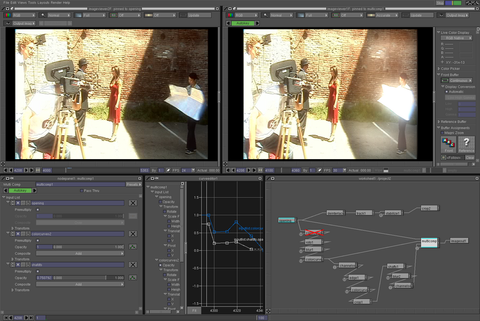
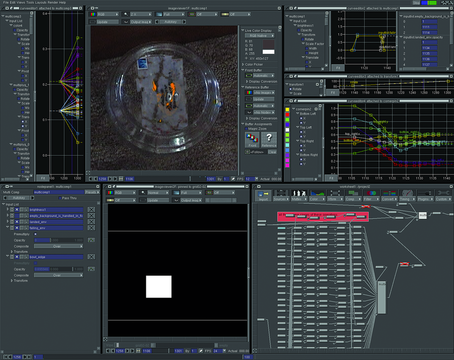
 ?
?
